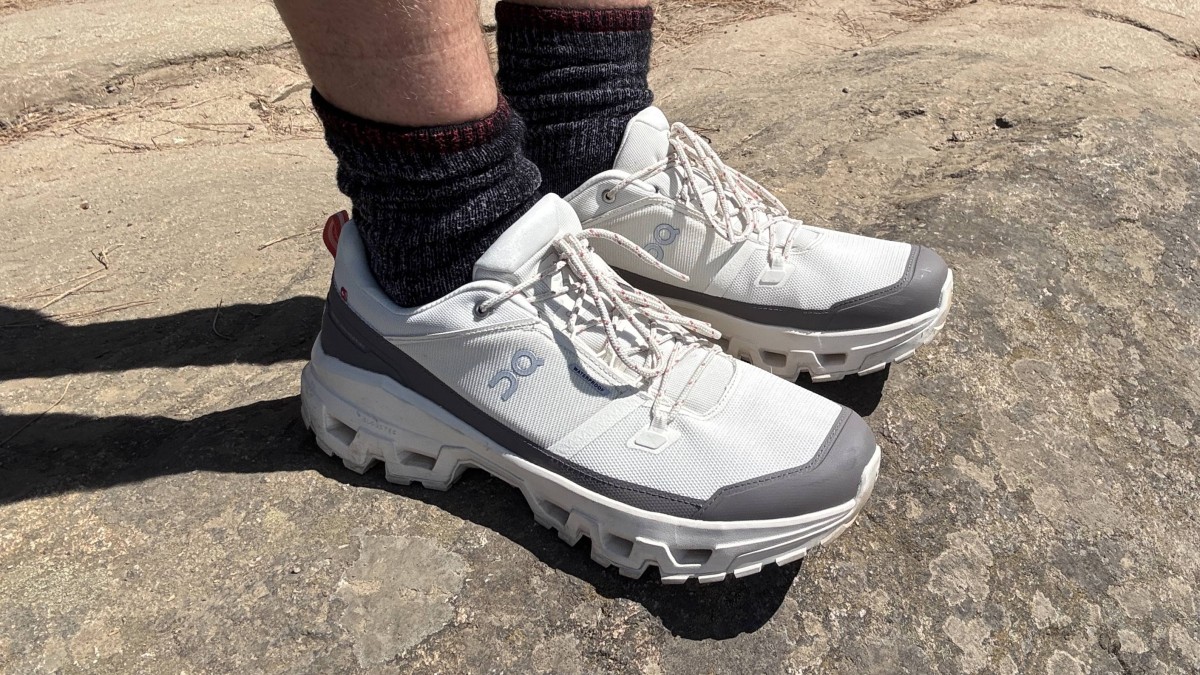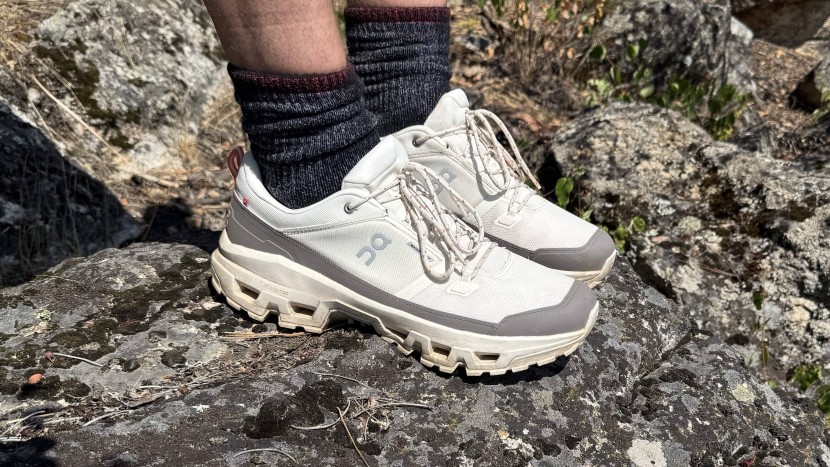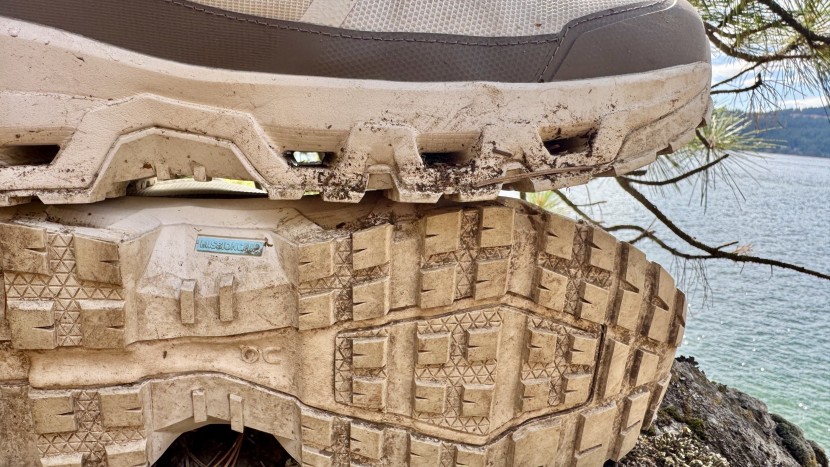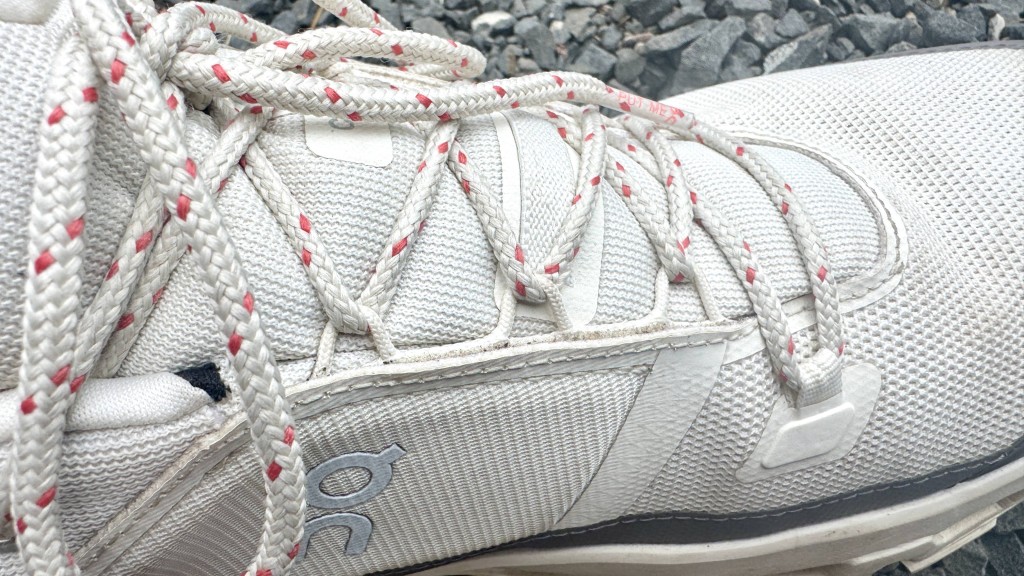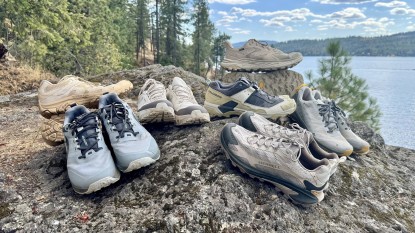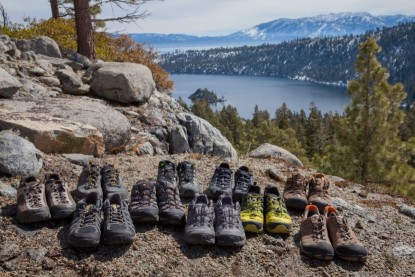
Our Verdict
Our Analysis and Test Results
The first thing we noticed about the On Cloudrock Low Waterproof is the stylish vibe. In fact, we were somewhat dubious as to how well they'd hold up under duress during our outdoor testing sessions. When we started looking a little closer, however, it was clear that these Swiss-designed trail shoes were created by someone who has spent time in the mountains, making them trail-ready. After taking these hikes in Idaho, from packed dirt to mountain lake shorelines, we didn't want to take them off once we returned to town.
Comfort
The On Cloudrock Low Waterproof is a master at absorbing impacts. The wide heel looks a bit clunky at first, but the heel-to-toe transition makes striding on stone feel like walking on astroturf. It's that good.
The upper, however, isn't quite as wonderful as the footbed. The fit is true-to-size and there's no break-in period required, but the fit of the upper is high-volume and sort of vague. This means most everyone's foot will fit inside the interior, but few feet will slide in feeling like home — more like visiting a good friend's house. Similarly, the lacing system doesn't have a lot of room for variability. The end result is great comfort for casual hiking, but it reduces support on more technical terrain.
Support
The On Cloudrock Low Waterproof footbed, with the midsole and waffle-like tread pattern, is predictable and springy. On flat ground, as well as on direct forward climbs and direct downward descents, our lead tester could put down the miles with ease. This means that in these situations, support was excellent.
When traversing down a steep slope at an angle, the vague fit and mediocre lacing pattern made our tester's feet feel as if they shifted to the edge of the shoe, which can feel like your shoe is going to tip over. What does all this mean? The Cloudrock Low delivers outstanding support on easy-to-medium terrain but feels a bit top-heavy on steep traverses. A better lacing system with improved lockdown could make these a bit more workable in the tough stuff.
Traction
Once again, for anything straight on, the Cloudrock Low is a winner. Even though the individual lugs on the new Missiongrip outsole are fairly close together and not particularly aggressive, the Cloudrock gains traction through surface area — the sole is wider than those that are on many hiking shoes.
We experienced some sliding on loose, gravelly surfaces, likely because the lugs are floating more than biting. All in all, the Cloudrock is an average performer on very technical terrain, but it excels on hard-packed dirt and rock trails where heel-to-toe transitions are the norm.
Water Resistance
On doesn't use a name-brand waterproof/breathable membrane, but we can say it works well. We experienced no leaks during a morning hike that included a section of wet grass, nor did we experience leaks on stream crossings and our water tests.
When it comes to flood height, the On Cloudrock Low Waterproof tied our top performer with a tall flood height of 3.87 inches. This means that you've got about a 1/2 extra height to work with compared to most when you're quick-stepping through a mountain stream or a trail puddle.
Weight
The Cloudrock Low weighs in on the higher end of the scale, but it feels lighter on foot than we expected. Our size 14 pair weighed in at 2.42 pounds.
While these are a bit heavy, our lead tester says they feel much lighter when walking multiple miles on mostly flat ground, likely due to the impact resistance, springy feel, and smooth heel-to-toe transition.
Durability
We love the polyester upper and full-perimeter TPU overlay and toe cap. The material quality is excellent, and the fit and finish is precise. We like the extra stitching around the toe cap, which should help keep it from peeling up over time like some that only use adhesives. The upper is thick enough to fend off sharp sticks and rocks that always seem to jut out unexpectedly on alpine trails. After more than 20 miles in a variety of terrain, we're not seeing even a hint of wear anywhere.
The only obvious potential durability drawback is the lacing system, which uses a thin cord as eyelets, which appears to be sewn and may be glued or fused to the edge of the upper. We're gentle when we snug our laces down, but if we were going to be doing a lot of steep off-trail climbing, this system wouldn't be our first choice. Let's put it this way: While our laces haven't worn through, detached, or broken yet, this isn't the shoe we'd choose to take on aggressive terrain far from the trailhead. For use on moderate trails, though, we expect competitive mileage.
Should You Buy the On Cloudrock Low Waterproof?
If you're looking for a versatile, waterproof cruiser to cushion your steps, the On Cloudrock Low Waterproof is hard to beat. It's rugged enough to take off the trail, though not the best on steep traverses. Still, if you want a trail shoe with an outdoor vibe and an understated modern flair that can do most anything, this is your shoe.
What Other Hiking Shoes Should You Consider?
One of the top flatland trail cruisers is the cushy Hoka Anacapa 2 Low GTX, which looks and feels more like a running shoe. Performance is remarkably similar overall. If you want a more off-trail capable, steep hill option, consider the La Sportiva Spire GTX or the Salomon X Ultra 5 Gore-Tex.


